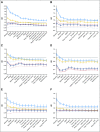Racial and Ethnic Disparities in Cancer Survival: The Contribution of Tumor, Sociodemographic, Institutional, and Neighborhood Characteristics
- PMID: 29035642
- PMCID: PMC5756323
- DOI: 10.1200/JCO.2017.74.2049
Racial and Ethnic Disparities in Cancer Survival: The Contribution of Tumor, Sociodemographic, Institutional, and Neighborhood Characteristics
Abstract
Purpose Racial/ethnic disparities in cancer survival in the United States are well documented, but the underlying causes are not well understood. We quantified the contribution of tumor, treatment, hospital, sociodemographic, and neighborhood factors to racial/ethnic survival disparities in California. Materials and Methods California Cancer Registry data were used to estimate population-based cancer-specific survival for patients diagnosed with breast, prostate, colorectal, or lung cancer between 2000 and 2013 for each racial/ethnic group (non-Hispanic black, Hispanic, Asian American and Pacific Islander, and separately each for Chinese, Japanese, and Filipino) compared with non-Hispanic whites. The percentage contribution of factors to overall racial/ethnic survival disparities was estimated from a sequence of multivariable Cox proportional hazards models. Results In baseline models, black patients had the lowest survival for all cancer sites, and Asian American and Pacific Islander patients had the highest, compared with whites. Mediation analyses suggested that stage at diagnosis had the greatest influence on overall racial/ethnic survival disparities accounting for 24% of disparities in breast cancer, 24% in prostate cancer, and 16% to 30% in colorectal cancer. Neighborhood socioeconomic status was an important factor in all cancers, but only for black and Hispanic patients. The influence of marital status on racial/ethnic disparities was stronger in men than in women. Adjustment for all covariables explained approximately half of the overall survival disparities in breast, prostate, and colorectal cancer, but it explained only 15% to 40% of disparities in lung cancer. Conclusion Overall reductions in racial/ethnic survival disparities were driven largely by reductions for black compared with white patients. Stage at diagnosis had the largest effect on racial/ethnic survival disparities, but earlier detection would not entirely eliminate them. The influences of neighborhood socioeconomic status and marital status suggest that social determinants, support mechanisms, and access to health care are important contributing factors.
Figures

Comment in
-
Advancing the Science of Cancer Health Disparities Research.J Clin Oncol. 2018 Jan 1;36(1):1-3. doi: 10.1200/JCO.2017.76.0496. Epub 2017 Oct 31. J Clin Oncol. 2018. PMID: 29087770 No abstract available.
References
-
- Howlader N, Noone AM, Krapcho M, et al.: SEER Cancer Statistics Review (CSR) 1975-2013. http://seer.cancer.gov/csr/1975_2013/
-
- Clegg LX, Li FP, Hankey BF, et al. : Cancer survival among US whites and minorities: A SEER Program population-based study. Arch Intern Med 162:1985-1993, 2002 - PubMed
-
- Aizer AA, Wilhite TJ, Chen MH, et al. : Lack of reduction in racial disparities in cancer-specific mortality over a 20-year period. Cancer 120:1532-1539, 2014 - PubMed
Publication types
MeSH terms
Grants and funding
LinkOut - more resources
Full Text Sources
Other Literature Sources

